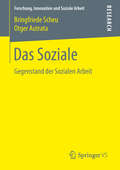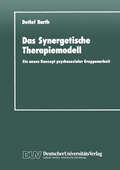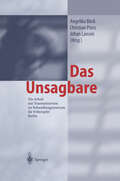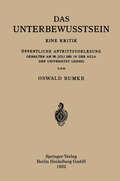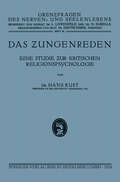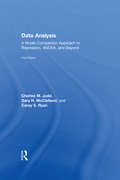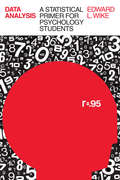- Table View
- List View
Das Schweigen verstehen: Über Aphasie
by Luise LutzAphasie verstehen und behandeln Wenn Sie – beruflich oder im privaten Umfeld - mit aphasischen Menschen zu tun haben, finden Sie hier den "Schlüssel" zum Verständnis ihrer komplexen, durch Sprachlosigkeit dramatisch veränderten Lebenssituation, und Sie lernen erfolgreiche Behandlungsansätze kennen und anwenden. Informativ, praxisnah, anschaulich Die Autorin, erfahrene Sprachtherapeutin und klinische Linguistin, vermittelt Ihnen * eine leicht verständlich und spannend geschriebene Einführung in die Prozesse normaler Sprachfunktionen und die Mechanismen der bei Aphasie gestörten Sprache, * Behandlungsvorschläge für einen systemorientierten, ganzheitlichen Sprachaufbau, der von den zuvor beschriebenen sprachlichen Funktionsweisen ausgeht, * spannenden Zugang zur Praxisarbeit mit vielen Patientengeschichten, authentischen Textbeispielen aus der Therapie und Erfahrungsberichten von PatientInnen und Angehörigen. Aktualisiert In der 3. Auflage neu: * im Theorie-Teil aktuelle Erkenntnisse aus der Neurologie über die Arbeit der Sprachprozesse; * im Therapie-Teil mehr Transparenz und Praxisnähe durch eine neue Gliederung und Aktualisierung vieler praktischer Aspekte; * jetzt durchgehend optische Orientierungshilfen zum Lernen, Verstehen, Nachschlagen. "...Ein kluges und liebevolles Buch... Es ist allgemeinverständlich und dabei doch wissenschaftlich exakt, hat viele Berichte, Zeichnungen und Wortfindungsbeispiele von Aphasikern, die das Buch mitgestaltet haben... (Frankfurter Rundschau)
Das Schweigen verstehen: Über Aphasie
by Luise LutzDie Autorin, erfahrene Sprachtherapeutin und klinische Linguistin, liefert Lesern mit dieser Einführung den „Schlüssel“ zum Verständnis der Lebenssituation von Menschen, die unter Aphasie leiden. Behandelt werden in dem Band die normale Sprachverarbeitung und die Fehlfunktionen bei Aphasie ebenso wie Therapien für einen ganzheitlichen Sprachaufbau. Neben konkreten Anleitungen zur individuellen patienten- und alltagsorientierten Therapie eröffnet die Autorin anhand zahlreicher Patientengeschichten einen Einblick in die Praxis.
Das serotonerge System aus neurologischer und psychiatrischer Sicht
by Horst Przuntek Thomas MüllerDie verschiedenen Facetten der serotonergen Neurotransmission bei psychiatrischen und neurologischen Erkrankungen werden interdisziplinär diskutiert. Die gewonnenen Erkenntnisse lassen sich im Sinne eines ganzheitlichen Therapieansatzes bündeln und optimieren.
Das Soziale: Gegenstand der Sozialen Arbeit (Forschung, Innovation und Soziale Arbeit)
by Bringfriede Scheu Otger AutrataDer Gegenstand der Sozialen Arbeit ist aus ihrer Denomination ableitbar: Der Gegenstand der Sozialen Arbeit ist das Soziale. Allerdings fehlt bislang eine wissenschaftlich gesicherte Bestimmung des Sozialen. Bringfriede Scheu und Otger Autrata nehmen eine Bestimmung und Definition des Sozialen vor. Damit wird wissenschaftliche Soziale Arbeit zu einer eigenständigen Disziplin mit dem Alleinstellungsmerkmal, dass sie Grundlagenforschung zum Sozialen leistet. Die Festlegung auf das Soziale und das soziale Handeln als Gegenstand ist auf die professionelle Soziale Arbeit fortzuführen: Bringfriede Scheu und Otger Autrata erläutern, dass die Förderung sozialen Handelns das verbindende Merkmal professioneller Sozialer Arbeit in unterschiedlichen Arbeitsfeldern ist.
Das TMS-Buch: Handbuch der transkraniellen Magnetstimulation
by Hartwig Roman Siebner Ulf ZiemannBislang konkurrenzlos auf dem deutschsprachigen Fachbuchmarkt: Das anschauliche TMS-Buch gibt Einsteigern und Fortgeschrittenen den aktuellen und umfassenden Überblick über alle wichtigen Themen. Die transkranielle Magnetstimulation erlaubt die schmerzlose Stimulation des menschlichen Gehirns. Sie ist eine neue, hoch innovative und nicht-invasive Methode mit breit gefächerten Einsatzmöglichkeiten, u.a. in der Neurologie und Psychiatrie. Wer sich für den "state of the art" interessiert und TMS verstehen will, ist hier genau richtig - von der Routinediagnostik über Befunde und den Einsatz in der Hirnforschung bis hin zu Therapie und Anwendung.
Das Unsagbare: Die Arbeit mit Traumatisierten im Behandlungszentrum für Folteropfer Berlin
by A. Birck C. Pross J. LansenJedes Jahr finden etwa 450 Menschen, die Opfer von politischer Verfolgung, Folter oder Bürgerkrieg geworden waren, im Behandlungszentrum für Folteropfer Berlin (BZFO) medizinische, psychotherapeutische und soziale Hilfe. Zehn Jahre nach seiner Entstehung ziehen jetzt die Mitarbeiter des BZFO eine Bilanz ihrer Arbeit und dokumentieren die unterschiedlichsten Aspekte der Traumatherapie.Der Schwerpunkt des Buches liegt auf der Beschreibung des therapeutischen Handelns mit schwerst traumatisierten Menschen aus anderen Kulturen. Damit ist es eine unentbehrliche Hilfe für alle, die im psychosozialen oder medizinischen Bereich mit Flüchtlingen zu tun haben, aber auch für Therapeuten, die mit anderen schwer traumatisierten Menschen arbeiten.
Das Unterbewusstsein: Eine Kritik Öffentliche Antrittsvorlesung Gehalten am 20. Juli 1921 in der Aula der Universität Leipzig
by Oswald BumkeDieser Buchtitel ist Teil des Digitalisierungsprojekts Springer Book Archives mit Publikationen, die seit den Anfängen des Verlags von 1842 erschienen sind. Der Verlag stellt mit diesem Archiv Quellen für die historische wie auch die disziplingeschichtliche Forschung zur Verfügung, die jeweils im historischen Kontext betrachtet werden müssen. Dieser Titel erschien in der Zeit vor 1945 und wird daher in seiner zeittypischen politisch-ideologischen Ausrichtung vom Verlag nicht beworben.
Das Unterbewusstsein: Eine Kritik
by Oswald BumkeDieser Buchtitel ist Teil des Digitalisierungsprojekts Springer Book Archives mit Publikationen, die seit den Anfängen des Verlags von 1842 erschienen sind. Der Verlag stellt mit diesem Archiv Quellen für die historische wie auch die disziplingeschichtliche Forschung zur Verfügung, die jeweils im historischen Kontext betrachtet werden müssen. Dieser Titel erschien in der Zeit vor 1945 und wird daher in seiner zeittypischen politisch-ideologischen Ausrichtung vom Verlag nicht beworben.
Das Verhältnis der Psychiatrie zu ihren Nachbardisziplinen
by Hans Heimann Hans Jörg GaertnerUnter Mitarbeit zahlreicher Fachwissenschaftler
Das Ziel ist im Weg: Störungsverständnis und Therapieprozess im Psychodrama
by Michael SchachtSeit den Arbeiten des Psychodrama-Gründers J. L. Moreno hat sich das Psychodrama stetig weiterentwickelt. Dennoch fehlt, so die These des Autors, eine aktuellen Ansprüchen genügende genuin psychodramatische Therapietheorie. Er entwickelt in diesem Buch ein zeitgemäßes Störungsverständnis sowie ein Modell therapeutischer Prozesse, um daraus spezifische Therapiestrategien abzuleiten. Diese werden an vielen Fallbeispielen erläutert. Verfahrensübergreifend zeigt der Verfasser Verbindungen zu aktuellen psychotherapeutischen Ansätzen auf. Er betont die Integrationskraft des Psychodramas, das in der aktuellen Therapielandschaft spezifische Akzente setzen kann. So ist das Buch nicht nur für PsychodramatikerInnen von Interesse, sondern für alle in beraterischen und therapeutischen Berufsfeldern Tätigen, die sich über aktuelle Entwicklungen jenseits des eigenen verfahrensspezifischen Tellerrands informieren möchten und Hilfen für ihre praktische Arbeit suchen.
Das Ziel ist im Weg: Störungsverständnis und Therapieprozess im Psychodrama
by Michael SchachtSeit den Arbeiten des Psychodrama-Gründers J. L. Moreno hat sich das Psychodrama stetig weiterentwickelt. Dennoch fehlt, so die These des Autors, eine aktuellen Ansprüchen genügende genuin psychodramatische Therapietheorie. Er entwickelt in diesem Buch ein zeitgemäßes Störungsverständnis sowie ein Modell therapeutischer Prozesse, um daraus spezifische Therapiestrategien abzuleiten. Diese werden an vielen Fallbeispielen erläutert. Verfahrensübergreifend zeigt der Verfasser Verbindungen zu aktuellen psychotherapeutischen Ansätzen auf. Er betont die Integrationskraft des Psychodramas, das in der aktuellen Therapielandschaft spezifische Akzente setzen kann. So ist das Buch nicht nur für PsychodramatikerInnen von Interesse, sondern für alle in beraterischen und therapeutischen Berufsfeldern Tätigen, die sich über aktuelle Entwicklungen jenseits des eigenen verfahrensspezifischen Tellerrands informieren möchten und Hilfen für ihre praktische Arbeit suchen.
Das Zungenreden: Eine Studie Ƶur Kritischen Religionspsychologie
by Hans RustDieser Buchtitel ist Teil des Digitalisierungsprojekts Springer Book Archives mit Publikationen, die seit den Anfängen des Verlags von 1842 erschienen sind. Der Verlag stellt mit diesem Archiv Quellen für die historische wie auch die disziplingeschichtliche Forschung zur Verfügung, die jeweils im historischen Kontext betrachtet werden müssen. Dieser Titel erschien in der Zeit vor 1945 und wird daher in seiner zeittypischen politisch-ideologischen Ausrichtung vom Verlag nicht beworben.
Das Zweite - kompakt: Neurologie, Psychiatrie, Psychosomatik (Springer-Lehrbuch)
by Juliane Bremer Heinz Wiendl E. N. Cho H. Thieme Volker Kollenbaum Klaus-Peter W. Schaps Oliver Kessler Ulrich FetznerDie erste Hilfe vor dem "Hammerexamen". Nur keine Panik! Zur effizienten Vorbereitung auf das 2. Staatsexamen gibt es jetzt die neue Prüfungsrepetitorienreihe aus dem Hause Springer. Von Studenten für Studenten: die Informationen sind knapp, einprägsam, studenten- und prüfungsgerecht aufbereitet und nicht überladen. Verlässlicher "Facharztcheck": jedes von Studenten geschriebene Kapitel ist von Fachärzten gegengelesen und korrigiert. Systematisch und in ausgefeilter Didaktik, nach dem neuen GK 2: alle Krankheitsbilder in Band I-VIII; alle Gesundheitsstörungen mit Differenzialdiagnosen und Wiederholung der Diagnostik und Therapie in Band IX.
Dasha's Journal: A Cat Reflects on Life, Catness and Autism (PDF)
by T. O. DariaJust a few weeks old, Dasha the cat found herself in a family with an autistic child. The publication of Temple Grandin's book Animals in Translation: Using the Mysteries of Autism to Decode Animal Behaviour turned the household into a research laboratory, with the humans observing Dasha's behaviours and the cat experimenting with the `human guinea pigs'. The feline perspective provides a new outlook on autism conditions, challenging long established stereotypes and analysing controversies in the field with an unbiased attitude and humour. The text is interspersed with Dasha's 'wisdoms', 'research notes' and definitions of concepts based on her own understanding, such as 'A pet shop is a place where humans come to be adopted by the animals who are brave enough to take a responsibility of looking after them.' Dasha's Journal provides research-based information in an amusing and accessible form and makes serious and complicated issues such as sensory perception, memory, communication, savant skills and challenging behaviours in autism easily understandable for the general reader.
Data Analysis: A Model Comparison Approach To Regression, ANOVA, and Beyond, Third Edition
by Charles M. Judd Gary H. McClelland Carey S. RyanData Analysis: A Model Comparison Approach to Regression, ANOVA, and Beyond is an integrated treatment of data analysis for the social and behavioral sciences. It covers all of the statistical models normally used in such analyses, such as multiple regression and analysis of variance, but it does so in an integrated manner that relies on the comparison of models of data estimated under the rubric of the general linear model. Data Analysis also describes how the model comparison approach and uniform framework can be applied to models that include product predictors (i.e., interactions and nonlinear effects) and to observations that are nonindependent. Indeed, the analysis of nonindependent observations is treated in some detail, including models of nonindependent data with continuously varying predictors as well as standard repeated measures analysis of variance. This approach also provides an integrated introduction to multilevel or hierarchical linear models and logistic regression. Finally, Data Analysis provides guidance for the treatment of outliers and other problematic aspects of data analysis. It is intended for advanced undergraduate and graduate level courses in data analysis and offers an integrated approach that is very accessible and easy to teach. Highlights of the third edition include: a new chapter on logistic regression; expanded treatment of mixed models for data with multiple random factors; updated examples; an enhanced website with PowerPoint presentations and other tools that demonstrate the concepts in the book; exercises for each chapter that highlight research findings from the literature; data sets, R code, and SAS output for all analyses; additional examples and problem sets; and test questions.
Data Analysis: A Model Comparison Approach To Regression, ANOVA, and Beyond, Third Edition
by Charles M. Judd Gary H. McClelland Carey S. RyanData Analysis: A Model Comparison Approach to Regression, ANOVA, and Beyond is an integrated treatment of data analysis for the social and behavioral sciences. It covers all of the statistical models normally used in such analyses, such as multiple regression and analysis of variance, but it does so in an integrated manner that relies on the comparison of models of data estimated under the rubric of the general linear model. Data Analysis also describes how the model comparison approach and uniform framework can be applied to models that include product predictors (i.e., interactions and nonlinear effects) and to observations that are nonindependent. Indeed, the analysis of nonindependent observations is treated in some detail, including models of nonindependent data with continuously varying predictors as well as standard repeated measures analysis of variance. This approach also provides an integrated introduction to multilevel or hierarchical linear models and logistic regression. Finally, Data Analysis provides guidance for the treatment of outliers and other problematic aspects of data analysis. It is intended for advanced undergraduate and graduate level courses in data analysis and offers an integrated approach that is very accessible and easy to teach. Highlights of the third edition include: a new chapter on logistic regression; expanded treatment of mixed models for data with multiple random factors; updated examples; an enhanced website with PowerPoint presentations and other tools that demonstrate the concepts in the book; exercises for each chapter that highlight research findings from the literature; data sets, R code, and SAS output for all analyses; additional examples and problem sets; and test questions.
Data Analysis: A Statistical Primer for Psychology Students
by Edward L. WikeThis book is intended for psychology majors and graduate students who are conducting experiments for the first time and are faced with the task of making sense out of their data. This much needed "how-to-do-it" text illustrates the application of statistical methods to the data from small samples. It also serves as a handbook, with twenty-two tables presented at the end of the text that will allow the student to carry out virtually every computation necessary in analyzing his data. Almost all of the examples and illustrations are drawn from actual experiments so that the student can see how professional scientists examine their data. The book also shows students the kinds of data that are encountered in psychological research, the kinds of questions investigators seek to answer, and how these questions are approached.The author asserts that statistics is not an abstract discipline but a tool in research. However, the book also imparts a philosophy of data analysis and its meaning, a concern for questions of the function of data analysis and the interpretations that legitimately can be drawn from data. In brief, Data Analysis asks: What kinds of data are met in psychological research? What can we do with these data? What can we conclude as a result of this doing?The book will be invaluable for students who, even though they may have taken a previous statistics course, are still unsure of what statistical techniques should be used in interpreting their data.
Data Analysis: A Statistical Primer for Psychology Students
by Edward L. WikeThis book is intended for psychology majors and graduate students who are conducting experiments for the first time and are faced with the task of making sense out of their data. This much needed "how-to-do-it" text illustrates the application of statistical methods to the data from small samples. It also serves as a handbook, with twenty-two tables presented at the end of the text that will allow the student to carry out virtually every computation necessary in analyzing his data. Almost all of the examples and illustrations are drawn from actual experiments so that the student can see how professional scientists examine their data. The book also shows students the kinds of data that are encountered in psychological research, the kinds of questions investigators seek to answer, and how these questions are approached.The author asserts that statistics is not an abstract discipline but a tool in research. However, the book also imparts a philosophy of data analysis and its meaning, a concern for questions of the function of data analysis and the interpretations that legitimately can be drawn from data. In brief, Data Analysis asks: What kinds of data are met in psychological research? What can we do with these data? What can we conclude as a result of this doing?The book will be invaluable for students who, even though they may have taken a previous statistics course, are still unsure of what statistical techniques should be used in interpreting their data.
Data Analysis, Machine Learning and Knowledge Discovery (Studies in Classification, Data Analysis, and Knowledge Organization)
by Myra Spiliopoulou Lars Schmidt-Thieme Ruth JanningData analysis, machine learning and knowledge discovery are research areas at the intersection of computer science, artificial intelligence, mathematics and statistics. They cover general methods and techniques that can be applied to a vast set of applications such as web and text mining, marketing, medicine, bioinformatics and business intelligence. This volume contains the revised versions of selected papers in the field of data analysis, machine learning and knowledge discovery presented during the 36th annual conference of the German Classification Society (GfKl). The conference was held at the University of Hildesheim (Germany) in August 2012.
Data Analysis with Machine Learning for Psychologists: Crash Course to Learn Python 3 and Machine Learning in 10 hours
by Chandril GhoshThe power of data drives the digital economy of the 21st century. It has been argued that data is as vital a resource as oil was during the industrial revolution. An upward trend in the number of research publications using machine learning in some of the top journals in combination with an increasing number of academic recruiters within psychology asking for Python knowledge from applicants indicates a growing demand for these skills in the market. While there are plenty of books covering data science, rarely, if ever, books in the market address the need of social science students with no computer science background. They are typically written by engineers or computer scientists for people of their discipline. As a result, often such books are filled with technical jargon and examples irrelevant to psychological studies or projects. In contrast, this book was written by a psychologist in a simple, easy-to-understand way that is brief and accessible. The aim for this book was to make the learning experience on this topic as smooth as possible for psychology students/researchers with no background in programming or data science. Completing this book will also open up an enormous amount of possibilities for quantitative researchers in psychological science, as it will enable them to explore newer types of research questions.
Data Analytic Techniques for Dynamical Systems (Notre Dame Series On Quantitative Methodology Ser.)
by Steven M. Boker Michael J. WengerEach volume in the Notre Dame Series on Quantitative Methodology features leading methodologists and substantive experts who provide instruction on innovative techniques designed to enhance quantitative skills in a substantive area. This latest volume focuses on the methodological issues and analyses pertinent to understanding psychological data from a dynamical system perspective. Dynamical systems analysis (DSA) is increasingly used to demonstrate time-dependent variable change. It is used more and more to analyze a variety of psychological phenomena such as relationships, development and aging, emotional regulation, and perceptual processes. The book opens with the best occasions for using DSA methods. The final two chapters focus on the application of dynamical systems methods to problems in psychology such as substance use and gestural dynamics. In addition, it reviews how and when to use: time series models from a discrete time perspective stochastic differential equations in continuous time estimating continuous time differential equation models multilevel models of differential equations to estimate within-person dynamics and the corresponding population means new SEM models for dynamical systems data Data Analytic Techniques for Dynamical Systems is beneficial to advanced students and researchers in the areas of developmental psychology, family studies, language processes, cognitive neuroscience, social and personality psychology, medicine, and emotion. Due to the book’s instructive nature, it serves as an excellent text for advanced courses on this particular technique.
Data Analytic Techniques for Dynamical Systems
by Steven M. Boker Michael J. WengerEach volume in the Notre Dame Series on Quantitative Methodology features leading methodologists and substantive experts who provide instruction on innovative techniques designed to enhance quantitative skills in a substantive area. This latest volume focuses on the methodological issues and analyses pertinent to understanding psychological data from a dynamical system perspective. Dynamical systems analysis (DSA) is increasingly used to demonstrate time-dependent variable change. It is used more and more to analyze a variety of psychological phenomena such as relationships, development and aging, emotional regulation, and perceptual processes. The book opens with the best occasions for using DSA methods. The final two chapters focus on the application of dynamical systems methods to problems in psychology such as substance use and gestural dynamics. In addition, it reviews how and when to use: time series models from a discrete time perspective stochastic differential equations in continuous time estimating continuous time differential equation models multilevel models of differential equations to estimate within-person dynamics and the corresponding population means new SEM models for dynamical systems data Data Analytic Techniques for Dynamical Systems is beneficial to advanced students and researchers in the areas of developmental psychology, family studies, language processes, cognitive neuroscience, social and personality psychology, medicine, and emotion. Due to the book’s instructive nature, it serves as an excellent text for advanced courses on this particular technique.



